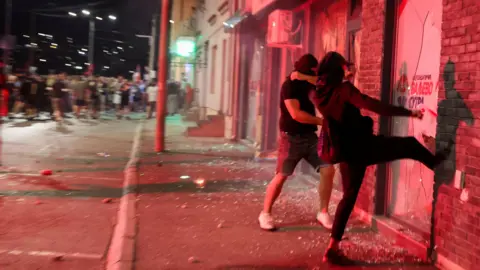### Recent Protests in Serbia: Violence and Political Turmoil
In a dramatic display of civil unrest, protests have escalated across Serbia, leading to violent confrontations between demonstrators and law enforcement. The Serbian Progressive Party (SNS), currently in power and led by President Aleksandar Vučić, has faced significant backlash from the populace. These protests erupted into chaos, particularly in Valjevo, where violence peaked with the setting ablaze of SNS offices. Riot police utilized stun grenades and tear gas to disperse small, masked groups attacking these facilities, indicating the severe tension that has gripped the nation.
As unrest continues for the fifth consecutive day, allegations of police brutality have surfaced, particularly in cities such as Belgrade and Novi Sad. The Ministry of Interior in Serbia refuted these claims, suggesting a divide between the government’s narrative and that of the protesters. Complicating this situation, Russia has publicly voiced its support for Vučić’s administration, asserting that it would not remain passive regarding the events in Serbia.
### Historical Context and Modern Implications
The roots of these protests can be traced back to a tragic incident involving the collapse of a railway station in Novi Sad in November of the previous year. This disaster, which resulted in the loss of 16 lives, symbolized the broader issues of corruption and negligence within the Serbian political system. Initially, protests focused on demands for accountability and thorough investigative measures following the station’s collapse. However, over time, calls for early elections and an end to Vučić’s long-standing rule have intensified, swelling the ranks of demonstrators.
The protests attract diverse crowds, including those advocating for anti-corruption measures. However, the peaceful nature of the demonstrations shifted during clashes on Wednesday when pro-government groups began staging counter-demonstrations, further inflaming tensions. Events on Saturday night saw riot police once again mobilized as activists took to the streets, demanding an end to the current government’s tenure and calling for early elections. The SNS party and its affiliated banners became focal points for public anger, leading to violent outbursts, including the shattering of windows at the Serbian Radical Party headquarters, a coalition ally of the SNS.
### Response from Authorities and Human Rights Concerns
In an effort to assuage public concerns about police conduct, Michael O’Flaherty, the Council of Europe’s Commissioner for Human Rights, urged Serbian authorities to exercise restraint, de-escalate hostilities, and address the issues surrounding police use of force. Observations of excessive police action have emerged, with unverified videos circulating online showing instances of brutality against civilians. The ongoing protests have not only become a symbol of discontent but have also raised significant questions regarding human rights and governmental accountability in Serbia.
### Political Ramifications
President Vučić, facing mounting dissent, has consistently rejected calls for early elections, framing the protests as part of a foreign conspiracy aimed at destabilizing his government. His recent comments on social media condemned the violence as “an expression of total weakness,” signaling a defensive posture in response to the uprising. Meanwhile, Russia’s Foreign Ministry reiterated its support for Vučić, emphasizing the importance of maintaining public order and security in the face of the protests. Their statement suggested that the police are acting within the bounds of the law to manage what they described as “violent mobs.”
### Conclusion: A Nation at a Crossroads
The situation in Serbia is emblematic of a society grappling with deep-seated issues such as corruption, governance, and civil liberties. As protests continue to engulf the nation, the demand for significant political change echoes across the streets. The tragic railway station incident may have been the catalyst, but the resulting demonstrations represent broader societal frustrations. With each passing day, the dynamics between the government and the populace will be crucial in shaping Serbia’s political landscape. As the protests unfold, observers will be keenly attuned to developments that could either strengthen democracy or lead to increased repression in this Balkan nation.












